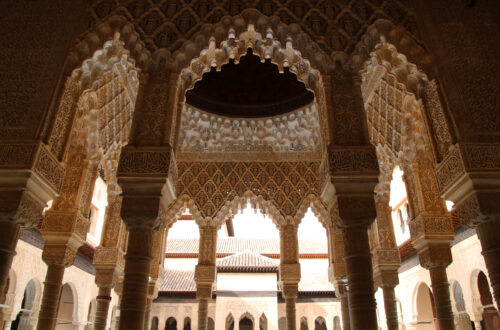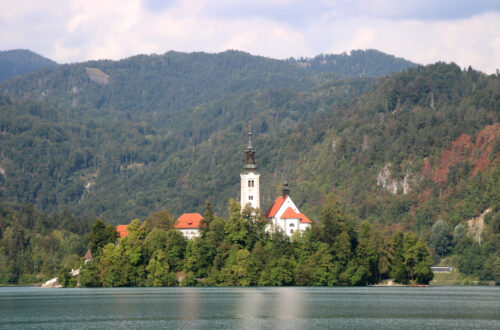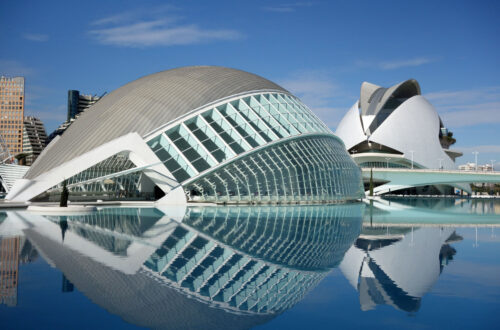Ireland
Itinerary: Wicklow Mountains – Glendalough – Kilkenny – Cashel – Lough Gur – Limerick – Bunratty – Knappogue Castle – Loop Head – the Cliffs of Moher – Doolin – the Burren – Galway – Connemara – Sky Road – Clonmacnoise – Tara – Dublin
On an early July morning we get up early to go to Amsterdam Airport, where our flight to Dublin is supposed to leave at 8:50 a.m.. But that’s not going to happen. The flight is delayed and we don’t take off until a few minutes before eleven. It’s a short flight (one hour and ten minutes) and at 11:15 local time we set foot on Irish soil. We pick up our rental car. It’s the first time I’m going to drive on the left side of the road, in a car with the steering wheel on the right. Everything that should be in a car is there, just not where I expect it. Once on the road I have to be careful, but I get used to it quite easily.
Wicklow Mountains and Glendalough
Once we leave the Dublin ring road, the traffic gets lighter, the roads narrow and the landscape becomes mountainous. We drive into the Wicklow Mountains, only a short distance from Ireland’s capital, but very sparsely populated, with hardly any villages. It’s a beautiful route down narrow roads along babbling brooks and through the rolling countryside for which Ireland is known. The Sally Gap does not offer the view that was promised, but Lough Tay, Powerscourt Waterfall and various other places where we stop are beautiful. Late afternoon we set up our tent in the town of Roundwood.
The next morning Ireland is covered by a think layer of gray clouds with occasional drops of rain. We head towards Glendalough, a monestic site set in a truly beautiful valley with wooded hills and two deserted lakes. There’s a serene peace, which is occasionally disturbed by a group of tourists. After Glendalough we head towards Meeting of the waters, not much more than a crossing of two rivers.
Kilkenny, Cashel and Lough Gur
The long journey to Kilkenny goes through very hilly landscape, again on narrow roads and through hardly noticeable villages. In Kilkenny we set up the tent again and visit the town. The next morning we visit Kilkenny Castle, a beautiful castle with a nice garden. Then we drive to Cashel via the Cashel scenic drive. Again similar narrow roads and beautiful views. The rock of Cashel is a fortress located on a mountain, a beautiful place with a beautiful view. Next we drive to Lough Gur. Around this lake there are a number of archaeological excavations that we of course visit. After this we relax on the bank of the lake.
Limerick, Bunratty and Knappogue Castle
After being awakened by the birds, we leave for Limerick, where we visit St. John’s Castle and the city itself. To me Limerick is disappointing. The castle is not that special and the industrial city of Limerick is not worth a visit. We leave earlier than planned and drive towards Bunratty. Here we see the local castle. We then make our way north to Knappogue Castle. This beautiful castle is located in a beautiful deserted spot, where hardly any visitors come. Via back roads we drive towards Lough Derg, a scenic drive. At the lake we relax for a while and enjoy the view. All these beautiful sites are followed by a long drive via Ennis to Kilkee, on the west coast of County Clare. We reluctantly settle for an expensive campsite with hardly any facilities.
Loop Head, the Cliffs of Moher and Doolin
Early evening we head for Loop Head. There the stories of Ireland’s beautiful west coast with its spectacular cliffs turn out to be true. The next day we enjoy more beautiful views over spectacular cliffs when we visit the famous Cliffs of Moher. Next we drive on to Doolin, a small village that, according to our travel guide is known for its musical evenings in the local bars. In the evening, we pay a visit to O’Connors, said to be the most famous pub in the village.
The Burren
After a rainy day, when we visit the Ailwee Cave near Ballyvaughan, we drive the Burren Tour: to Doonagore Castle and Ballinalacken Castle, via the coastal route to Black Head, down the Caher Valley, past the Poulnabrone dolmen and via Kilfenora back to Doolin. The Burren is an impressive barren landscape with a green center. The Poulnabrone dolmen is a bit smaller than expected, but the route is worth it.
It’s Monday morning when we leave Doolin for County Galway. Along the way we visit Dunguaire Castle as well as Aughnanure Castle. The last one in particular is worth it, a very beautiful, not too big castle, situated on a hill with beautiful views and a perfect lawn for a picnic in front of it. Salthill, where we spend the night, is a hideous tourist destination, where the campsite is disturbed nearly all night by English and Northern Irish camping hooligans. So we had little sleep and leave as soon as possible.
Galway, Connemara and Sky Road
We visit the city of Galway, after which we leave for Connemara. We drive via the south coast to Carraroe. Here is a beach of coral and shell pieces. We continue the coastal route and then drive inland towards Rinvyle. The landscape changes quickly (dryer, more stone, less vegetation) and the mountains of Connemara can already be seen in front of us. The campsite is once again as it should be: quiet, located on a bay.
First we visit Connemara National Park, but this park doesn’t really impress. Then we drive to Clifden, where the so-called Sky Road offers beautiful views over the island-rich north-west coast of Ireland. The next day we drive the scenic drive through Connemara. Unfortunately, the weather is not as nice as we hoped for, but still. First we stop at the beautifully situated Kylemore Abbey, then we drive from Leenane to Maan Cross and back via Cong and the Joyce county scenic drive.
Clonmacnoise, Tara and Dublin
Via the Lough Inagh Valley in Connemara we start heading back in the direction of Dublin. We drive to Clonmacnoise and spend the night in Ballykeeran. The next day w drive along some back roads to Tara (about 25 kilometers north of Dublin), from where a large part of Ireland was once governed. Not much remains than a hill that looks like a failed golf course.
After a good night’s sleep we drive to Dublin. It’s a bright summer day and like Dubliners, we spend this Sunday afternoon in St Stephen’s Green, the city park. The next day we visit Dublin Castle and Trinity College (if only Leiden University had such a campus!). We walk down Crafton street, the main shopping street in Dublin, and then we drive to the Guinness Brewery. After an hour in the sun in Phoenix Park we visit the Temple Bar district. In the bar with the same name we have a Guinness.
When our trip in Ireland comes to an end, we have driven more than 2,000 kilometers. Without damage, which is a bit of an achievement when you consider that regularly sheep show up in front of the car, or dogs, or other drivers driving like crazy. Except around Dublin there are no highways in Ireland, most regional roads are narrow country roads where you can barely pass each other, but where the speed limit is nevertheless about 80 km/h.
This trip has shown us that Ireland is a beautiful country, very green, with a varied landscape and beautiful views. With the exception of a few cities, Ireland is very rural. Where in the Netherlands every village has at least a few houses and a church, a typical Irish village is a few houses and a pub. And then there are of course the many castles and ruins of castles. Many. At some point you just drive past them (“oh no, not another castle…”). The two mountainous areas we’ve been to: the Wicklow Mountains south of Dublin and Connemara to the west were beautiful, but what perhaps made the most impression was the Atlantic coast with its spectacular cliffs.


